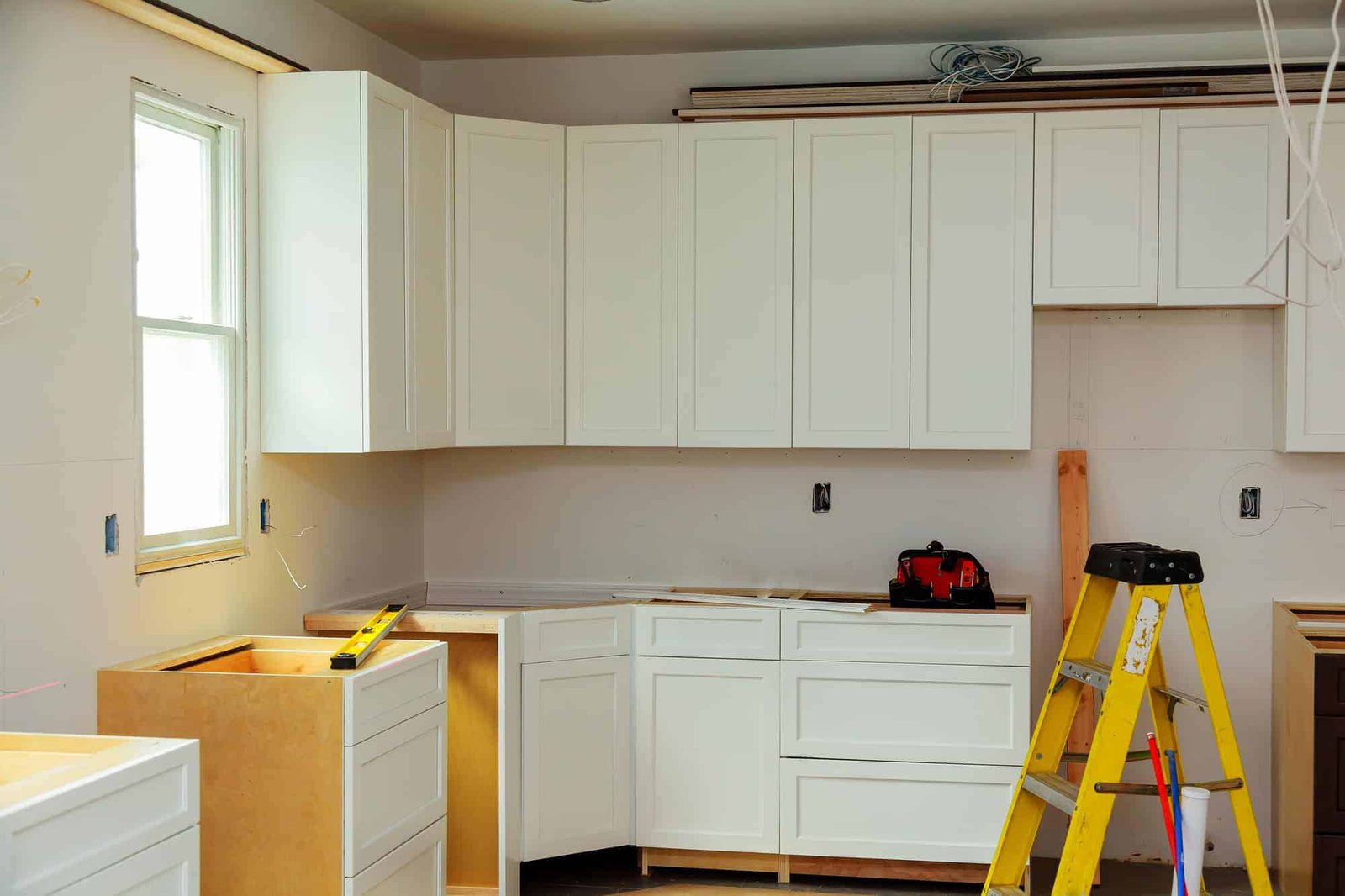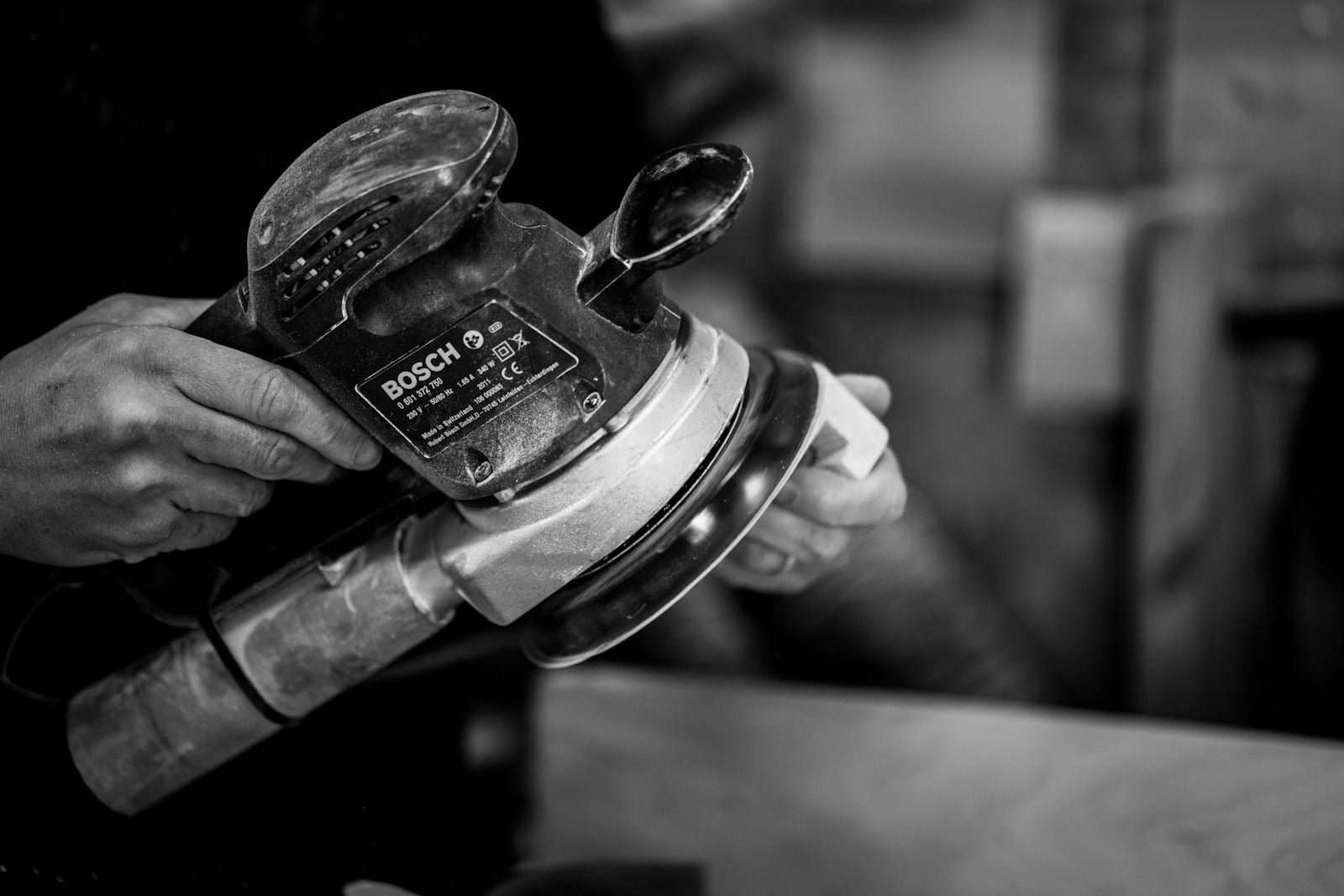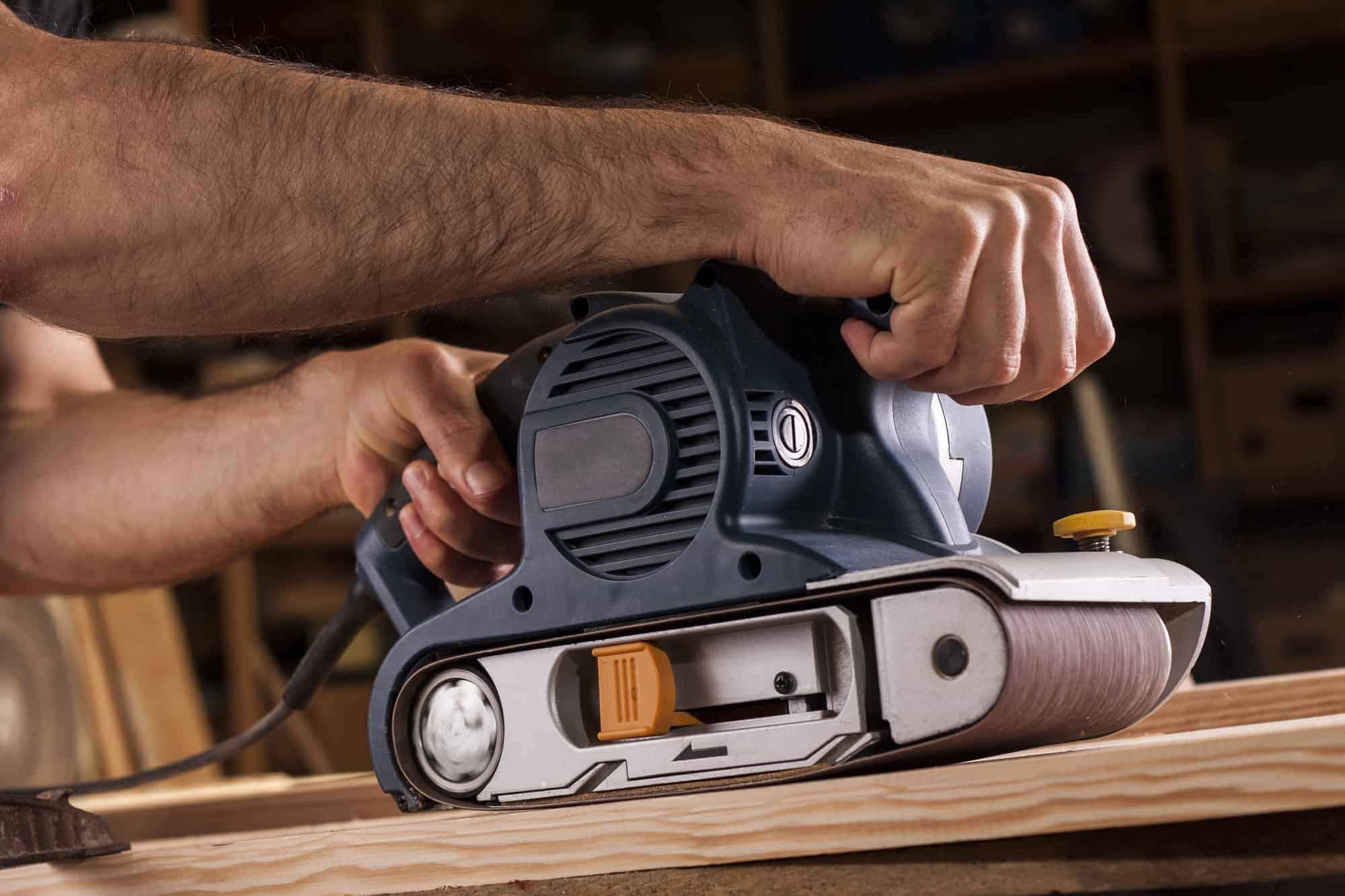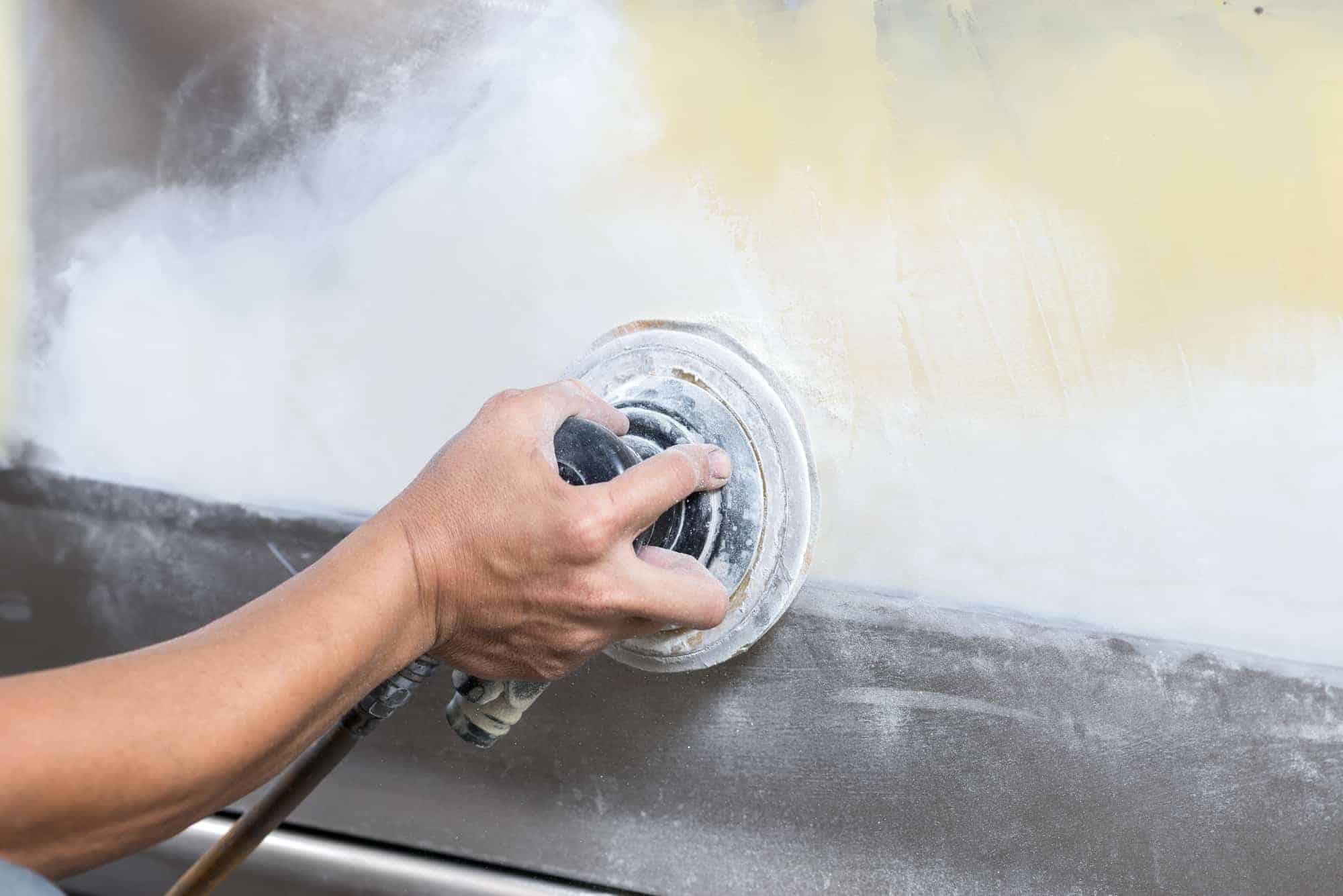Table of Contents
Sanding, It’s a huge subject, and quite honestly, some of us fellow woodworkers don’t like it. I mean it’s a long process. As you already know, refinishing a cabinet consists of four main parts.
There is the process of removing the existing finish, progressive sanding, conditioning, and application of the final clear coat. This process isn’t that hard, but it needs the right tools. And if you are looking to create a professional-looking finish, you need to get yourself the best sander for cabinets.
You need to get the job done professionally (even if it’s DIY), and this guide will only focus on sanders that are best for finishing a cabinet.
Let’s talk about the ones that you don’t want to use for finishing work. And that is belt sanders. They are a fantastic tool and do a great job of removing the existing finish and material quickly.
But you don’t want to use them when it comes to cabinet finishing because you won’t get that smooth look and, in the end, you will get a rather very aggressively sanded look.
You need to move onto a finer sander that can flex a little bit to match up to a surface without spinning too aggressively. You can try orbital sanders, but I wouldn’t recommend them either.
I prefer dual-action random orbital sanders that don’t spin too aggressively but rather work at a moderate pace.
In this list, you will see a bunch of different sanders for refinishing cabinets that a lot of woodworkers use for their cabinet projects.
Cabinet Sander Quick Comparison
Best Sander for Cabinets or Kitchen Cabinets- Reviews
Random orbital sanders can cover more ground faster without damaging the cabinet frame or peeling off too much material. If you don’t want to worry about damaging the cabinets, here is a list of some of the best cabinet sanders on the market.
My #1 Choice: DEWALT DWE6423K Variable Speed Random Orbit Sander – Best Pick
Let’s jump right into it. This one is a beast. It has performance that can even please a professional.
This sander will protect its valuable components from dust and has a lockable one-handed dust bag. Also, the switch is dust-sealed to prolong the lifespan of the switch.
Quick Facts
This top of the line random orbit sander from Dewalt features a 3.0 Amp motor. This powerful motor can deliver up to 12000 OPM. The best part about it is its easily connectable dust port. You can hook it up with a Dewalt dust collector and locks right into place. No need for any duct tapes or adapters.
It has variable speed, plus a dust-sealed on/off switch, which is neat because it prevents dust from getting into the inner components and it also has a short-height ergonomic design. The manufacturer made it shorter to minimize the distance between the workpiece and user.
Compared to other sanders in this list, there aren’t a lot of vibrations, which is why this product is my no.1 pick among all the products in this guide. It glides smoothly, and you won’t even feel the vibration. Not only is it easy to use, but it’s also very comfortable.
Sanding is a long process, and comfort is a must for this type of tool. It’s a nice and comfortable sander. You can hold it up at the top, down the handle, or on the front – there are so many ways to use this product, and you will find rubber molded grips everywhere. All I can say is, you won’t go wrong with this one.
PROS
- The dust port easily attaches to a dust collector
- Dust sealed on and off switch
- Powerful 3.0 Amp motor
- Uniquely designed to minimize vibration
- Comfortable to hold and use
CONS
- Only compatible with DeWalt dust collectors.
My #2 Choice – Festool 574993 Random Orbital Sander ETS 125 REQ-Plus
If you want the ideal sander for maximum surface quality, Festool has a very good offering.
For an average woodworker, their products might seem a little pricey, but considering the quality you will be getting, it’s worth the investment. This manufacturer is known for its unique sanding stroke.
Quick Facts
When it comes to applying a stain, the last thing you would want is swirl marks. Very often these have nothing to do with the tool. Rather it depends on how the tool swirls the sanding grit pads, and that feature alone made this orbital sander our second-best pick. The ETS 125 is versatile and features Festool’s finest sanding stroke.
Whether you are pre-sanding or finishing, this should be your go-to one-handed cabinet sander. This isn’t a big tool, and it isn’t meant to replace the larger ones. It’s compact, easy to use, and ideal for budget-conscious people. I know there are other top brands and top-of-the-line tools, but the quality of this is on-par with the top tier models.
The ease of use and result speaks for itself. If you want to save money in the long run, go with Festool. Their dust collector and portable HEPA filter is cheaper than a lot of premium brands but work just as well. This random orbital sander has plenty of power and perfect for vertical sanding.
With this, you can put in less effort and get a professional finish. Thanks to its small strokes, swirl marks are a thing of the past. Of course, you will need high-quality sandpaper and proper techniques. With that being said, if you even have a basic grasp of how to control an orbit sander, I’d say you won’t be disappointed.
PROS
- Swirl free sanding with unique sanding stroke
- Easy to use and lightweight
- Ideal for vertical sanding
- Won’t leave any swirl marks
- Fully Rubberized grip for comfort and better fit
CONS
- Expensive but worth it
My #3 Choice – Makita Sheet Finishing Sander
The name speaks for itself. It’s from Makita, and as with all their products, it’s a solid one. This brand often receives praise for its quality product line.
Let’s talk about the best feature of this tool first. And that will be the lock button. You don’t have to keep the trigger pressed while sanding for a good 10 minutes straight. It’s a handy feature to have as it puts less strain on the hand.
Quick Facts
This finishing sander is small and easy to use. You can hold it in a couple of different ways or reposition your hands to achieve a better grip. It’s quiet and has plenty of power. The dust bag, on the other hand, isn’t that great but does the job.
If you are not a big fan of using a dust bag, then you won’t find any issues/problems with this one. Just make sure to use a proper dust collector because the bag it comes with won’t be enough. You can operate this one using one hand, but two hands will give you better control.
Changing the sandpaper is very easy, and so is using the tool. It’s also quite sturdy, and the motor is able to deliver 11,000 OPM. This high power ensures a smooth finish and increases efficiency. You will also experience fewer vibrations thanks to its counterbalance system built into this sander.
Finally, let’s talk about comfort. These products are meant to be used for a long time, and for that reason, comfort is important. It has rubber mold grips with a lot of holding positions. To increase user comfort, it has a large two-finger trigger switch. The lock-on button is also easy to reach, which is needed for continuous use. This is a great choice if you’re doing lots of cabinets at once (e.g. a large kitchen refinishing project).
PROS
- The grip and handle ensure a better fit
- Easy to use and lightweight
- Fewer vibrations thanks to its counterbalance system
- Conveniently located trigger and lock-on button
- Quality product from Makita
CONS
- The dust collection bag needs improvement
4. SKIL 7492-02 2.8 Amp 5-Inch Random Orbit Sander- Budget Pick

For woodworkers, especially beginner woodworkers, price is always a consideration. And if you are on the market for a budget pick, this is the one. This one has what they call a pressure control. It has an LED light bar that does a great a job of letting you know how much pressure you are applying.
This one has a standard Velcro on the bottom that will take any 5-inched hole-punched sanding disks that are out there. The filter is much better than most other tools I’ve seen. If you have a vacuum to hook up to the sander, you don’t need to use the filter.
If you have standard shop vac and with a little bit of duct tape, you can practically eliminate 99% of the dust. Keep in mind that this is a prep sander and it is only good for sanding out a moderately rough surface. But it works really well as a finish sander.
This disk spins and the pads move in an elliptical pattern which eliminates swirl marks and results in a smooth finish. The micro-filtration system does a great job at collecting even the finest of dust before they get a chance to get airborne.
When sanding, the trick is to let the tool all the work. You just need to guide the tool and apply proper techniques. You don’t want to put too much pressure on the sander, or it’s just going to slow the process down. That’s why the pressure control technology comes in handy. You have the freedom the control the amount of pressure you want to put in.
Pros
- High-quality dust canister
- Integrated pressure control technology
- Powerful 2.8A motor
- Sealed dust switch and built-in dust port
- Comfortable and easy to use
Cons
- Not meant for heavy use
5. Bosch ROS20VSC Palm Sander

A prevalent complaint most professionals have about orbital sanders is the swirl marks they leave after project completion. However, Bosch’s new product can save you from such troubles. Their in-built pad dampening mechanism prevents any swirl marks on the workpiece.
Furthermore, this product features adjustable speed control. You can select the machine’s speed ranges from 7,500 to a maximum 12,000 OPM. Therefore, you can adjust the velocity according to your project at hand. Altering the speed from one point to another is straightforward, making it user-friendly.
This sander also comes with an exceptionally ergonomic design perfect for ensuring maximum comfort. Users can have multiple grip positions without any impediments. The manufacturers minimized the vibration frequency to lessen fatigue. Therefore you can operate it for extended periods without any physical discomfort.
Bosch makes dust extraction more convenient by including a microfilter mechanism. This system can trap the smallest of debris. The in-built dust canister restricts the formation of dust and other materials.
During use, you can breathe more freely and don’t need to wear a mask on the job. The dust-sealed switch and vacuum hose make the extraction of debris very easy.
Finally, the signature Hook and Loop disc attachment make this one of the best products in the market. With many sanders, the sanding pad comes off frequently making the task harder than necessary – but this varies depending on who uses it.
However, with this product’s functionality as a Velcro adhesion material, you will not have to worry about any detachment during your woodworking project.
Pros
- Built-in pad dampening mechanism prevents swirling marks
- Hook and Loop disc attachment prevents any disconnection from the pad and sander
- Extensive speed control ranging from 7500 to 12000 OPM
- Incredible dust extraction mechanism enabled with microscopic filter
- Ergonomic design for maximum comfort
Cons
- Changing the dust canister can be challenging
Also Read- Best Detail Sander For Detailing & Corner Sanding
6. PORTER-CABLE Random Orbit Sander

Porter-Cable has a bunch of random orbital sanders, but I like this one the most because it’s a basic tool, no-frills and does a great job. This one is durable, reliable, and you can’t go wrong with this one. There aren’t a lot of bells and whistles to it, but there are some features that are neat.
This one allows you to attach a shop vac and also gives you the option for the job site. The ergonomic design is something that you will love. It has a smaller head with a thin neck with a wider body.
You can easily grab it from the top, or you can grab it by the neck. Both positions are very comfortable to hold.
The fan is counterbalanced to reduce vibrations, and since it is evenly balanced, it does a great job at reducing fatigue. With a 100% ball-bearing construction, durability shouldn’t be a concern. The trigger switch is sealed to keep out dust from getting in.
This product is going to last a long time. While it’s built sturdy, getting your hands on of these won’t break your bank. My only concern would be the cord. I don’t think it’s long enough. You need to be either close to a power station or buy extension cables.
Apart from that, there isn’t much to fault with this one. The finish-system is controlled and it’s ideal for a DIY woodworker or trim sanding work. It’s great for surface prep work and smoothing out seams. This compact tool is lightweight, comfortable to hold, and can be used for professional sanding applications.
Pros
- Lightweight and compact
- Capable of producing 12,000 OPM
- Counterbalanced dual-plane fan
- Controllable pad speed
- Minimizes gouging during start
Cons
- The cord isn’t long enough
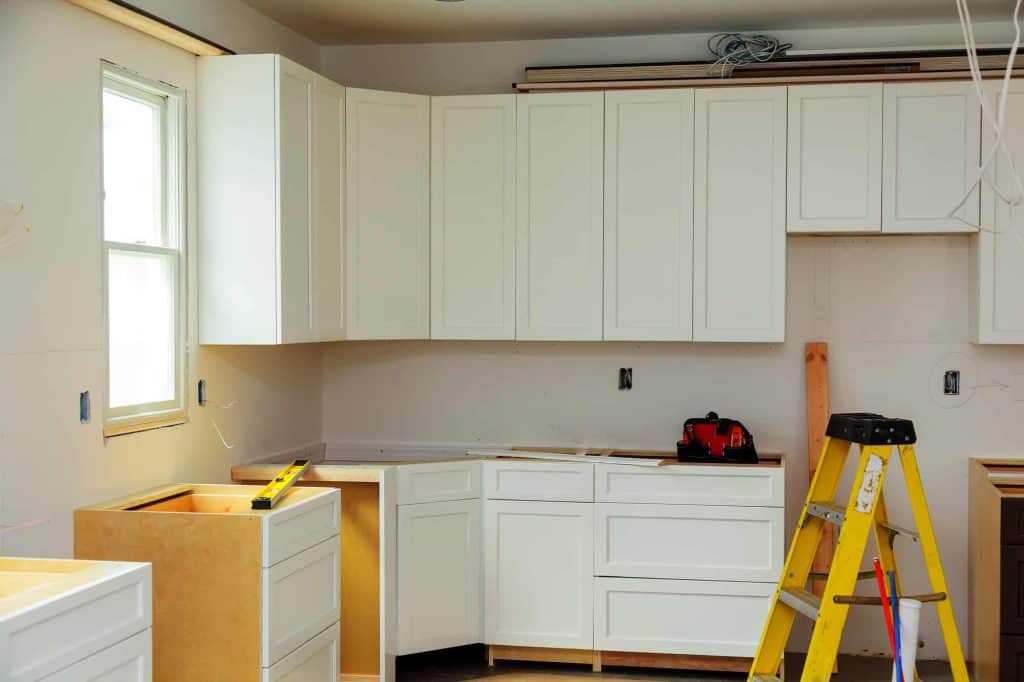
Features to Consider Before Buying
Sanding cabinets can be a tricky and complicated procedure, and you need to ensure that you get a decent product for your project.
Below, I’ve compiled a list of essential features you should look for before buying the best sander for cabinets – particularly kitchen cabinets.
Power
While you’re looking for a suitable sander in the market, a central consideration should be the power it packs. When scoping out a potential sanding tool, you should be mindful of the motor’s quality. The power is quantified in amps; so look out for the numbers 2.5 amps, 3.0, etc.
The low-specs and budget-friendly devices generally feature an amp range of 2.5 to 2.8. In contrast, the high-end power sanders can extend up to a whopping amount of 4 amps. In the case of typical home decoration, you won’t require more than 3.5 amps of power. Anything exceeding that number could prove troublesome for a novice.
However, if you want a versatile device to employ in multiple difficult projects, then having a high-end motor would prove beneficial. Besides power, another vital consideration is the RPM/ OPM number. A standard quality sander features 1200 RPM, which is sufficient for any DIY cabinet project.
Size
Size matters, especially when it comes to choosing a perfect sander. If you’re working on a flat surface, chances are, you won’t have tight corners. If so, consider yourself lucky because bulky orbital sanders have a hard time reaching constricted places.
A safe and smart buyer’s choice is to opt for a product that is compact. However, do not compromise quality or motor-potential for size. Instead, find a sander that is an amalgamation of comfort, lightweight, grippy handle, and adequate power. This combination will allow you to complete projects quickly and without problems.
Dust Extraction
Another handy feature to be mindful of is the dust collection facilities. Most random orbit sanders allow excellent dust extraction. Usually, the product comes with a vacuum-sealed bag. However, if you’re doing multiple cabinets, you can modify it and add a shop vac that collects dust more efficiently.
Our expert recommendation is to purchase the latter one because you can work continuously without changing the bag. Another feature to look out for is the micro-filtration system. This mechanism will exceptionally decrease the amount of debris in the air.
Having a micro-filtration system enables you to operate the machine without constantly covering your face.
Comfortable Design
While scouring through the market, aim for ergonomically designed sanders. They fit perfectly in your hand and make working on your project easier. Although sanders are typically a compact machine, some of them can be quite bulky. If the product mandates the use of both hands, then you’re going to have to put in more work.
Make sure to look for the placement of dust bag and switch, so they don’t prove inconvenient. If their positioning compromises your comfort, then it’s better to search for a different product. The ability to conveniently operate the machine will double your work speed and reduce fatigue.
FAQ
1- Is it imperative to sand my cabinets before painting?
Not necessarily. The rule of thumb is, slight sanding with 120-grit paper or sponge if the surface is even. In contrast, double work if it is rough; begin with a 100-grit coarser paper to remove bumps, and finish with 120-grit paper to prevent any sand marks.
2- What do I use to remove dust or wood after sanding?
The best way to do it is to use a vacuum with a bristle attachment. This mechanism prevents any wet stain or finish.
3- What do I need to clean the cabinet after sanding?
The materials you’ll require to clean are a dish soap that cuts through grease, a dry towel, a dust cloth, and a soapy sponge.
4- Is it possible to sand off varnish?
Yes, it is. If you use 150-grit sandpaper, then you could comfortably do it. Remember to go with the wood grain instead of going against it.
5- What is the efficient way to sand cabinets?
Firstly, use your electric sander and 100-grit sandpaper. Afterward, employ a 150 or 180-grip sandpaper, do this along the wood grain. Finally, clean the dust off.
Conclusion
DIY cabinet projects can be both rewarding and challenging. The difficulty can be remediated if you have the right tool for the job!






